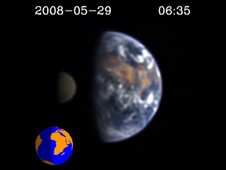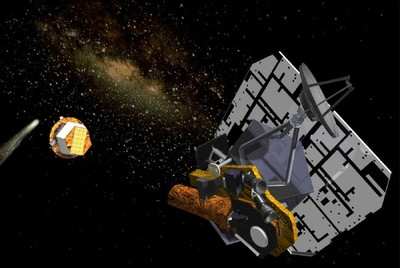How's This For A New Perspective?
 NASA's Deep Impact spacecraft has
created a video of the moon transiting (passing in front of) Earth
as seen from the spacecraft's point of view 31 million miles away.
Scientists are using the video to develop techniques to study alien
worlds.
NASA's Deep Impact spacecraft has
created a video of the moon transiting (passing in front of) Earth
as seen from the spacecraft's point of view 31 million miles away.
Scientists are using the video to develop techniques to study alien
worlds.
"Making a video of Earth from so far away helps the search for
other life-bearing planets in the Universe by giving insights into
how a distant, Earth-like alien world would appear to us," said
University of Maryland astronomer Michael A'Hearn, principal
investigator for the Deep Impact extended mission, called
EPOXI.
Deep Impact made history when the mission team directed an
impactor from the spacecraft into comet Tempel 1 on July 4, 2005.
As ANN reported, NASA recently extended the
mission -- redirecting the spacecraft for a flyby of comet Hartley
2 on November 4, 2010.
EPOXI is a combination of the names for the two extended mission
components: a search for alien (extrasolar) planets during the
cruise to Hartley 2, called Extrasolar Planet Observations and
Characterization (EPOCh), and the flyby of comet Hartley 2, called
the Deep Impact eXtended Investigation (DIXI).
During a full Earth rotation, images obtained by Deep Impact at
a 15-minute cadence have been combined to make a color video.
During the video, the moon enters the frame (because of its orbital
motion) and transits Earth, then leaves the frame. Other spacecraft
have imaged Earth and the moon from space, but Deep Impact is the
first to show a transit of Earth with enough detail to see large
craters on the moon and oceans and continents on Earth.
"To image Earth in a similar fashion, an alien civilization
would need technology far beyond what Earthlings can even dream of
building," said Sara Seager, a planetary theorist at the
Massachusetts Institute of Technology, Cambridge, MA, and a
co-investigator on EPOXI. "Nevertheless, planet-characterizing
space telescopes under study by NASA would be able to observe an
Earth twin as a single point of light -- a point whose total
brightness changes with time as different land masses and oceans
rotate in and out of view. The video will help us connect a varying
point of planetary light with underlying oceans, continents, and
clouds -- and finding oceans on extrasolar planets means
identifying potentially habitable worlds."
"Our video shows some specific features that are important for
observations of Earth-like planets orbiting other stars," added
Drake Deming of NASA's Goddard Space Flight Center in Greenbelt,
MD, the deputy principal investigator for EPOXI, and leader of the
EPOCh observations. "A 'sun glint' can be seen in the movie, caused
by light reflected from Earth's oceans, and similar glints to be
observed from extrasolar planets could indicate alien oceans. Also,
we used infrared light instead of the normal red light to make the
color composite images, and that makes the land masses much more
visible."
That happens because plants reflect more strongly in the
near-infrared, Deming explained. Hence the video illustrates the
potential for detecting vegetated land masses on extrasolar planets
by looking for variations in the intensity of their near-infrared
light as the planet rotates.

The University of Maryland is the Principal Investigator
institution, leading the overall EPOXI mission, including the flyby
of comet Hartley 2. NASA Goddard leads the extrasolar planet
observations.
FMI: Watch The Videos Here
And Here!
 NTSB Final Report: Rutan Long-EZ
NTSB Final Report: Rutan Long-EZ ANN FAQ: Turn On Post Notifications
ANN FAQ: Turn On Post Notifications Classic Aero-TV: ICAS Perspectives - Advice for New Air Show Performers
Classic Aero-TV: ICAS Perspectives - Advice for New Air Show Performers ANN's Daily Aero-Linx (06.28.25)
ANN's Daily Aero-Linx (06.28.25) Aero-News: Quote of the Day (06.28.25)
Aero-News: Quote of the Day (06.28.25)




